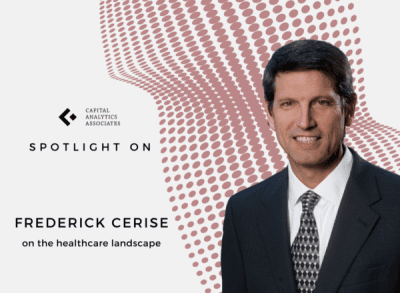Spotlight On: Frederick Cerise, President & CEO, Parkland Health
 October 2023 — Frederick Cerise, president and CEO of Parkland Health, sat down with Invest: to discuss the current trends across healthcare’s landscape affecting hospitals, plans for further expansions, how population growth has affected the sector and more.
October 2023 — Frederick Cerise, president and CEO of Parkland Health, sat down with Invest: to discuss the current trends across healthcare’s landscape affecting hospitals, plans for further expansions, how population growth has affected the sector and more.
What is the current state of the healthcare sector in North Texas, and what is Parkland Health’s role in it?
It is a busy sector, no doubt. We are coming off of COVID, and we see upticks every now and then but they are nothing like what we saw in the past few years. People are able to focus on healthcare issues beyond COVID now. Certainly for Parkland, and I suspect for the other health systems, we are seeing more of a return to what business looked like in 2019. Our volumes are back to pre-COVID numbers in hospital admissions, procedures and the like. We are as busy as we have ever been. For context, Parkland has the busiest single emergency department in the country. We did about a quarter of a million visits per year before COVID, and we are climbing back up to that number now. Our outpatient clinics have seen exponential growth at 14%, which was intentional. We see this as an area that needs ongoing attention. We are creating better access for patients. This will continue going forward.
What factors are driving the modern patient experience today?
A big one that sticks out is the shift to remote care. Telehealth, remote monitoring, hospital at home and more have evolved to achieve convenience and better access for patients. One of the things that got accelerated for everyone during COVID was video visits – this is one piece of our larger digital strategy and an ongoing goal. We are looking to see how to better use data to target care, be more precise in the populations we are serving and take other approaches to manage people more conveniently and safely at home. Before COVID, we had one big program that did this. Now, it is more intentional. We are growing our home dialysis program and getting more access through remote monitoring for those with chronic diseases.
What healthcare trends are impacting your operations?
From a business perspective, everyone has been dealing with staffing challenges. That is true for us as well. It seems to be stabilizing a bit now. Turnover is down because the healthcare landscape is slowing down. We are still dependent on contract labor, but we have reduced this by 30% since our peak usage. From a clinical perspective, there is a big trend to build out more convenient care that is accessible and sometimes home-based. It is also more important to have precise care. We are using more data to do so and are identifying populations that will benefit the most.
What legislation or regulation are you following?
Our uninsured patients make up 45% of our patient pool, and another 30% are on Medicaid. We tend to track health policy and payment policy decisions made at the state and federal levels. There are a number of ongoing items at the federal level. For example, there is a Disproportionate Share Hospital (DSH) payment program that will be ramped down over the next few years. Congress, fortunately, has chosen to delay those cuts. We will be watching this closely this year. The state is negotiating a portion of their Medicaid waiver with the federal government that identifies dollars for uncompensated care, which will be a big issue we have our eye on.
What strategies are you employing to bring new workers in?
People left the workplace because they needed to or could. They moved to contract positions because the pay was so good due to federal funding. The added COVID-related dollar infusions on a federal level have stopped, which puts more pressure on contract labor prices. Hospitals no longer have federal funds to pay staff. The pressure is on to reduce that quick fix. We have had our biggest nurse residency classes ever. We are finding new graduates and training them to take positions with us, and this has been the biggest difference thus far. Some classes have doubled. In addition, we upgraded our salaries to remain competitive in the market, added the number of trainees to replenish the workforce and are holding onto and recruiting who we can.
What are your priorities as the healthcare sector evolves over the next few years?
The population continues to grow, and you will see growing demands for healthcare services as a result. This may be tempered a bit by what we are seeing in the business today, which is the rising cost and shift in burden of payment from the insurer to the patient’s deductible in order to put downward pressure on costs. Even with that, you will see growing demand for services. For our health system, we will be meeting that with additional outpatient clinics. We have two significant expansions and a new clinic in our capital budget for the year. Physical capacity will increase and we will be more aggressive in our digital health strategy as well. This will allow us to accommodate more people.
For more information, visit:













